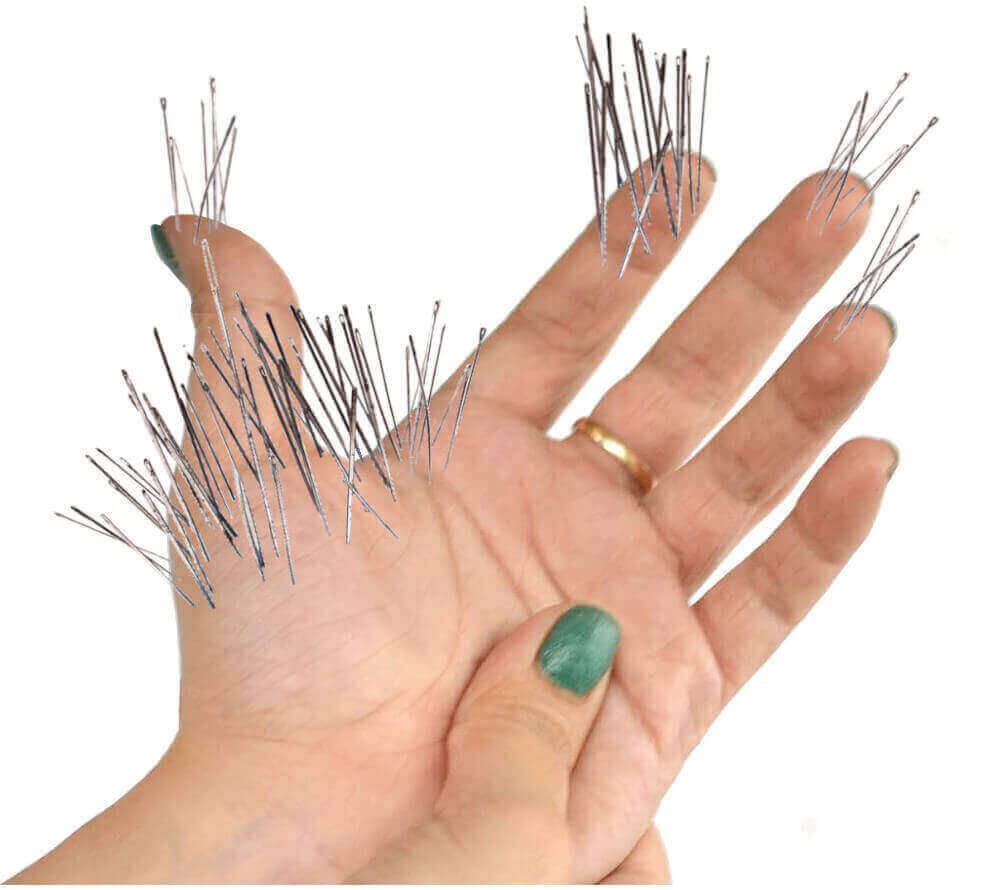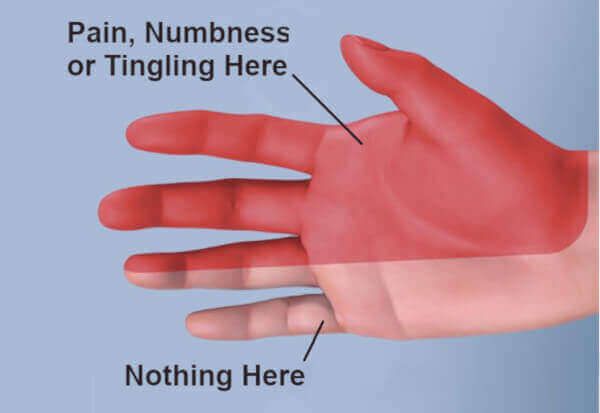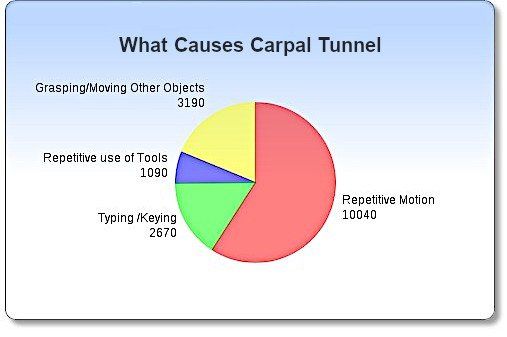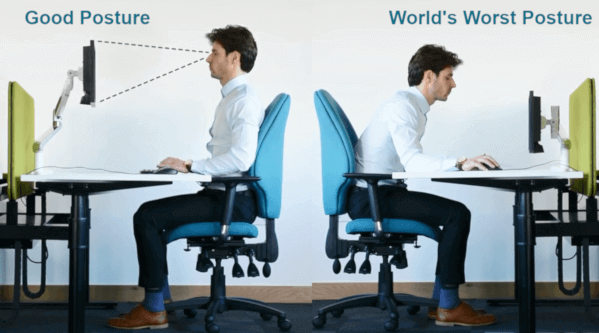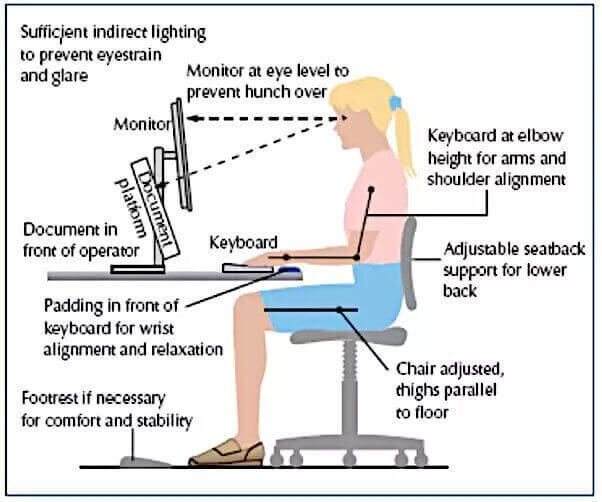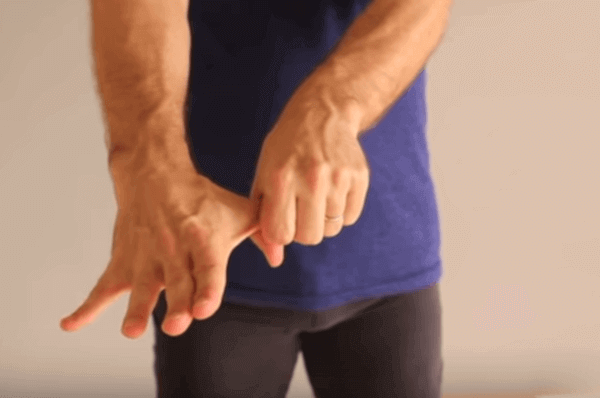Outstretch your right hand in front of you like you're saying, "Stop!" Use your other hand to pull your fingers backward. Be sure your elbows are straight. Hold this position for 5 seconds. Then drop your hands and shake them out. Repeat again. Then repeat the stretch for your left hand.
Guide to Carpal Tunnel Prevention
From Dr. Z - Carpal tunnel syndrome specialist
Carpal Tunnel Prevention & Workplace Changes
Table of Contents
Overview
Introduction
What is carpal tunnel syndrome?
What are carpal tunnel symptoms?
Causes of carpal tunnel syndrome
Who gets carpal tunnel syndrome
Tips for carpal tunnel prevention in the workplace
- Tip #1: Take regular breaks
- Tip #2: Maintain good posture
- Tip #3: Use the keyboard & mouse properly
- Tip #4: Do regular stretching exercises
- Core stretching exercise #1: STOP STRETCH
- Core stretching exercise #2: PRAYER STRETCH
- Core stretching exercise #3: FINGER INTERLACE STRETCH
- Core stretching exercise #3: THUMB STRETCH
Summary
FAQs
About
Overview
If you're looking for carpal tunnel prevention techniques, then there's a simple way to start. The first and most impactful way tis to adjust your everyday work environment. According to the National Institutes of Health, if you make even small changes to how you work then you can avoid ever having hand pain and numbness.
- Think you have carpal tunnel? Complimentary self-test
- Already know you have carpal tunnel? This Quiz tells you its severity
Introduction
Carpal tunnel syndrome is the most common type of hand injury in the USA. Ironically, it's also one of the easiest hand disorders to treat in its
mild stage. But it's one of the hardest to treat in the moderate or
severe stage.
Proper ergonomic changes can keep you from getting carpal tunnel syndrome. And as more and more of us work from home since the COVID-19 pandemic, the issue has never been more important.
Most people pay little attention to their sitting posture. The problem is that having poor sitting posture is like inviting carpal tunnel syndrome to visit. So if you type a lot or sit in an office chair most of the day, do yourself a favor. Make some changes now to prevent carpal tunnel from showing up later. And if you already feel signs of carpal tunnel syndrome, it will probably worsen without proper intervention. Be sure to take charge immediately in order to prevent suffering.
What is carpal tunnel syndrome?
Carpal tunnel syndrome is a neurological disorder of the hand. It occurs when tissues inflame and swell inside the wrist joint. That swelling pushes against the median nerve, which is a major nerve of the hand.
As the tissues push harder and harder on the median nerve, it ultimately gets crushed. That nerve crushing is the cause of all of the symptoms of carpal tunnel syndrome.
What are carpal tunnel symptoms?
Carpal tunnel symptoms primarily affect the palm side of the hand, thumb, and middle fingers. The little finger is never involved. The classic signs of carpal tunnel syndrome are:
Usually the thumb and forefinger are most affected. But it's important to note that symptoms of carpal tunnel syndrome never appear on the little (pinky) finger. Nor do they occur on the "blade side" of the hand (see illustration above).
At first, symptoms are barely noticeable. They usually begin by waking you up at night to shake out numb fingers. You may also want to rub the pain out. As the disorder worsens, symptoms start showing up during the daytime.
At first, symptoms of carpal tunnel don't usually appear while your hand is working. Instead, it occurs when your hand is resting. This distinguishes it from wrist tendonitis. You can tell the difference with some simple instructions.
As carpal tunnel progresses symptoms appear during the daytime. Performing small tasks like driving, holding a phone, reading a book, or turning a doorknob cause pain or numbness. Grasping can produce shooting electric shocks. fine movements like tying a shoelace, picking up coins, or using a pen are clumsy and difficult. You drop things often.
Finally, when you reach the severe stage of carpal tunnel syndrome, symptoms never let up. Any one or more of the above symptoms become a constant, ever-present problem. They greatly affect your quality of life.
Causes of carpal tunnel syndrome
No one has ever pointed to a direct cause of carpal tunnel syndrome. However, certain factors put you at risk for getting this disorder. These risk factors include:
- Performing stressful hand activities: certain harmful hand activities cause stress and are associated with carpal tunnel. This is one of the most serious of the risk factors, and one of the most preventable.
- Being female: the probability is several fold higher compared to males.
- Having a family member with it: genetics is a strong indicator for your potential for getting carpal tunnel syndrome.
- Being pregnant: pregnancy, especially in the third trimester, is a huge risk factor.
- Wrist fracture: any trauma to the hand and wrist increases the risk of carpal tunnel.
- Having diabetes: the best way to avoid carpal tunnel is to control your diabetes.
- Having rheumatoid arthritis: having RA puts you at high risk for carpal tunnel.
Since performing hand stressing activities is such a huge contributor to getting carpal tunnel, then making simple workplace changes can prevent it from ever happening.
Who gets carpal tunnel syndrome
Certain occupations are notorious for having workers with more carpal tunnel syndrome than other jobs. These occupations are:
- Cashier
- Hair styling
- Construction
- Graphic design
- Garment work
- Guitar playing
- Sonography
- Dental hygiene
- Assembly line work
- Transcription
- Janitor
- Video gaming
- Farming
- Driving
- Mechanic
- Fine arts
- Locksmith
- Housekeeping
- Massage therapy
Tips for carpal tunnel prevention in the workplace
There’s no doubt that certain jobs or workplace environments can lead to hand pain and carpal tunnel syndrome. Therefore, to prevent even more pain or numbness, you have to take action as soon as possible.
When it comes to your workstation, keep in mind that the more your wrist is bent or repetitively stressed, the greater the chances carpal tunnel will arise. Knowing this fact, you can redesign workstations and manual tasks to avoid such stresses.
Basically, carpal tunnel prevention is all about making your hands work with less stress and strain.
The National Institute for Occupational Safety and Health (NIOSH) recommends you focus prevention on your upper body and wrists. For instance:
- Make sure to maintain your wrists in a neutral (or level) position during work (no matter the type of work you do).
- Try to minimize any repetitive movements of the hand and fingers.
- Pay attention to your sitting posture, and don't hunch or slouch.
Tip #1: Take regular breaks
NIOSH reports the effectiveness of taking regular rest breaks in carpal tunnel prevention. In particular, these are 1-3 minute rest periods when you're actively using your hands. They reduce strain and discomfort without decreasing productivity.
The rest breaks should include:
- Quick hand stretching exercises (see below)
- Shaking out your hands at your sides
- Stretching your upper limbs
- Leaning back in the chair
- Squeezing your shoulder blades together
- Taking deep breaths
Tip #2: Maintain good posture
Good sitting posture is a key component of good hand health. As a matter of fact, the most important carpal tunnel prevention measures in your workplace focus on sitting posture. Why? If you disrupt the mechanical balance in your upper body, then the imbalance is transmitted to your limbs, particularly your hands. The pain and numbness result tissues not in balance.
Below are specific postural recommendations from NIOSH. Note how they apply to your computer workstation in the illustration above.
- Spine: Sit with your spine against the back of the chair with shoulders relaxed.
- Elbows: Elbows should rest along the sides of the body, with wrists at a slight downward tilt on the keyboard.
- Feet: Your feet should be firmly on the floor or on a foot rest.
- Typing materials: Papers and other typing material (including the screen) must be at eye level. This avoids your neck bending over the work.
- Thighs: Ensure you sit with thighs relatively level.
- Neck: Keep your neck flexible and head upright. As a result, circulation and nerve function to the arms and hands are not hindered.
- Chin: Maintain a level chin. Instead of moving your neck, glide your head slowly and gently forward and backward in small movements. As a result, you avoid neck discomfort.
- Furniture: In general, good office furniture makes a big difference. Poorly designed furniture is a major contributor to bad posture. Chairs should be adjustable for height. They should also have a backrest and lumbar support. If necessary, advise your employer of the "economics of ergonomics". For example, the medical or absentee costs of an injured employee are far more than a custom designed chair as type of carpal tunnel prevention.
- Standing desks:
These desks prevent you from slouching or hunching by forcing you to stand instead of sit. Standing will solve the postural problems associated with sitting for long periods. According to
Money.com these desks range in price from $100 to over $700, and they recommend 6 of them. Before using one, consult your doctor. Also be sure to set up the desk properly. Then ease into a standing work position gradually, with plenty of walking and sitting breaks at the beginning to avoid back strain.

Tip #3: Use the keyboard & mouse properly
Anyone sitting at a computer workstation all day should heed these tips about keyboards. They include mouse use and posture advice. In fact, these basic carpal tunnel prevention tips can protect your hands and wrists from ever seeing any hand pain whatsoever.
- Keys: The tension of the keyboard keys should be adjusted so they can be depressed without excessive force.
- Relax: Keep hands and wrists in a relaxed position to avoid excessive force on the keyboard.
- Mouse: Using a mouse poses a higher risk than keyboard use. Therefore, replace the mouse with a trackball if possible. A vertical mouse is also superior to a traditional one.
- Keyboard: Similarly, replace a standard keyboard with a jointed-type ("split") keyboard.
- Wrist pads: Use wrist rests or pads which fit under most keyboards. They keep wrists and fingers in a comfortable position. But NEVER rest your wrist on them. Rather, use them as a guide as to where to place your hands.
- Shoulders: Keep the mouse as close to the keyboard and your body as possible. This reduces shoulder muscle movement.
- Forearm: Hold the mouse lightly, with a relaxed forearm.
- Mouse pad: Cut your mouse pad in half to reduce movement.
- Over-stretching: Do not over-stretch your fingers on the keyboard. For combination keystrokes use two hands to avoid finger stretching.

Tip #4: Do regular stretching exercises
Regular stretching exercises are probably the most powerful techniques you can use for carpal tunnel prevention. In particular, finger, hand, and wrist stretching exercises help tendons glide more smoothly. This makes finger movement more efficient.
The best hand and finger exercises are called the 4 core stretching exercises. They take no more than 60 seconds to do. That way, you can do them every 30-60 minutes you work. You can do more involved stretching exercises if your symptoms are worse. But for the average person trying to avoid hand pain and carpal tunnel, the following are excellent exercises. Make them part of your work routine. If you do, you'll NEVER suffer from hand pain or carpal tunnel syndrome.
Pro Tip: Get a timer that chimes every 30 minutes to remind you to drop everything, stretch, and go back to working again.
Core stretching exercise #1: STOP STRETCH
Core stretching exercise #2: PRAYER STRETCH
Core stretching exercise #3: FINGER INTERLACE STRETCH
Core stretching exercise #4: THUMB STRETCH
Summary
Carpal tunnel prevention starts by making simple workplace changes. In fact, most changes require little or no cost at all; just simple adjustments to how you work. Maintaining good posture is among the most important factors in prevention. It can also reverse carpal tunnel symptoms if they already started.
FAQs
- Can preventive measures also reduce existing symptoms?
Yes, you can use the same measures if you already have mild carpal tunnel syndrome. However, if symptoms are moderate or severe, you will require more aggressive therapies.
- If carpal tunnel is such a huge problem in the workforce, why aren't more steps taken to lessen the problem?
In fact, numerous initiatives have been already implemented by NIOSH, OSHA, and the NIH. That's because the cost of prevention is far less than treatment.
- If I'm at high risk for developing carpal tunnel, will these measures prevent it?
There is no guaranteed way to prevent carpal tunnel syndrome. However, you can certainly reduce your risk by following the above recommendations.


